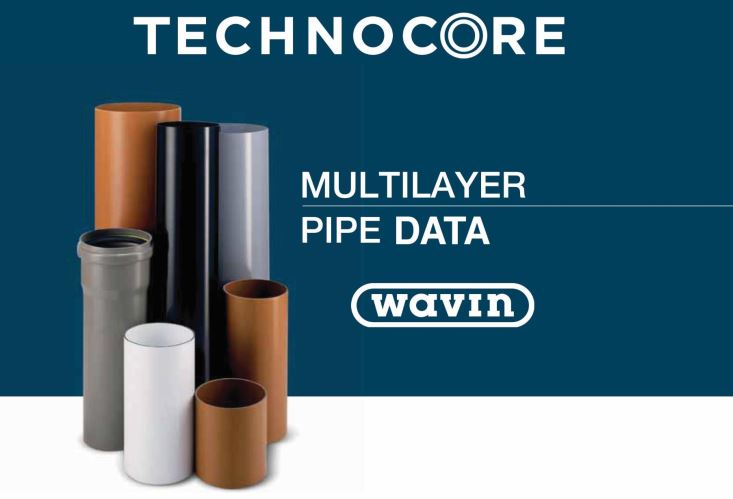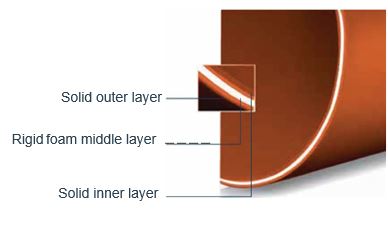
Technocore (Multilayer)

Technocore Technology
Tradionally in the Middle East, drain PVC pipes are extruded as a single solid monolayer during the manufacturing process. Technocore pipes are manufactures by a more complex production process and are composed of three distinct layers. This innovative technique produces pipes with improved performance properties whilst reducing the total material content.
Technocore Technology is proven
Hepworth’s Technocore technology was developed together with the Wavin Group, based in the Netherlands, one of the world’s leaders in PVC multilayer plastic pipe technology. Although this technology is new to the Middle East region, it has a solid track record and has been specified and used in Europe for over 25 years. Indeed, in Europe, the majority of PVC drain pipes are now manufactures using this technology. PVC multilayer plastics pipes are also widely accepted in North America, Australia, South Africa and many other countries around the world because of their superior performance and environmental advantages.

Technology is Green
Multilayer pipe technology was originally developed to improve the performance of pipes and to help the construction industry to achieve a lower carbon footprint, leading to a more sustainable world. There is a growing demand from governments, agencies and legislative bodies for greener products , i.e. those that require less energy and use fewer natural resources. Our new technocore technology, which reduces the usage of carbon during manufacturing, helps our customers meet increasingly tough new regulations and their own sustainability commitments.
Advantages of TECHNOCORE technology

The main benefits of the multilayer technology are,
- Pipes are up to 20% lighter, making handling easier and improving site efficiency.
- Pipes are stronger and have more impact resistance than conventional solid wall pipes, so they are less prone to damage when being transported and when handled on site.
- Reduced material usage means that there are environmental advantages with regard to the lower carbon footprint (16% reduction in CO2 emissions over the whole supply chain)
Also, despite their other advantages, multilayer pipes are still equal to conventional solid wall pipes in terms of:

Dimensional accuracy

Chemical resistance

Working life
New Technology Better Performance Better for the Environment

Better mechanical properties

Fast installation

16% less CO2
Fittings
Technocore multilayer pipes are fully compatible with existing PVC fittings and can be utilized with push-fit or solvent-welded coupling systems.
Technocore Pipe Dimension
Specification as per standard


Specification as per standard
Pipes are normally available and supplied with integral joints and solvent socket in 6m or 4m length.

Corrosion resistance
The major finding of a recent study is that PVC Pipes have the lowest overall failure rate when compared to cast iron, ductile iron, concrete and steel pipes.
PVC pipes won’t rush or corrode over time because it does not react with air and water the way metal does which results in a significantly longer lifetime the pipe.
Chemical resistance
PVC pipes exhibit excellent resistance to a wide range of chemical reagents in temperatures up to 50°C. PVC pipes can be used indoors or to transport chemicals or waste products without risk of materials eating through the pipe.
Operating temperature
Up to 60°C
Abrasion Resistance
PVC pipes exhibit outstanding resistance to wear and abrasion. PVC pipe has proven more durable than metal, concrete and clay pipe for the transport of abrasive slurries.
PVC is extremely tough and its abrasion resistance has been confirmed by numerous studies and over 50 years of proven service.
Flexibility – The flexibility of technocore pipes allow them to cope with drain movements, subsidence and expansive clays
Handling/Installation – The ease of handling, installation and transport provide overall project savings.
Easily Machined/Cut – It may be cut and machined with simple tools, ready for jointing, anywhere on the pipe barrel.
Rubber Ring Joints
The rubber ring joint is integrally moulded on one end of the pipe. The opposite (spigot) end of the pipe is chamfered and has a “depth of entry” mark near the end. Each joint is capable of handling some expansion and contraction as well as angular deflection. The seal ring is designed to provide a watertight joint at high and low pressures.

Solvent Weld Joint
Solvent cement jointing is a welding process and not a glueing process. If done correctly, separation will not be possible after the curing period. Jointing of pipe should be an interference fit between the components before solvent cement is applied. There are different solvent cements available for applications. Be sure to use the correct cement and that it has not “dried out’’ prior to use.
